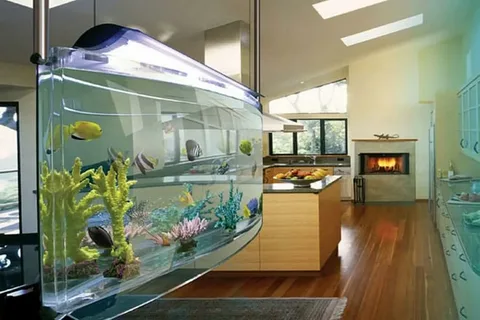Aquarium - meaning and illustration

TABLE OF CONTENTS
Reading time:
Last modified:
2023-04-10 00:00:00
1. Synonyms, etymology, translation, definition, examples and notes
1.1. Subject field:
- Fisheries engineering. (Hierarchy:
- Fisheries >
- Fisheries engineering )
- Aquiculture. (Hierarchy:
- Fisheries >
- Aquaculture >
- Aquiculture )
1.2. IPA transcription and prononciation for aquarium:
Aquarium BrE /əˈkweəriəm/ NAmE /əˈkweriəm/
Graph 1 : aquarium - Google ngram extract ( graph of term etymology and evolution. Source: Google ngram )
1.3. Etymology of Aquarium:
Mid 19th cent.: from Latin, neuter of aquarius ‘of water’, on the pattern of vivarium.1.4. French translation of aquarium:
Aquarium can be translated into French as:1.5. Definition of aquarium in fisheries:

1.6. Plural of aquarium:
Aquariums;
1.7. Notes on aquarium
Origin of aquariums
The term aquarium was first used by Philip Gosse, a 19th-century British naturalist. This work and a better scientific understanding of the relationships between plants, animals, and oxygen greatly extended aquarium usage. The first public aquarium in London, England, was established in 1853.Uses of aquarium
The goals of many aquariums are:- inform visitors about topics of aquatic biodiversity conservation, traditional fisheries, aquaculture, and endangered species;
- decoration;
- display, study, or maintain marine or freshwater aquatic organisms and systems;
Aquarium size and make-up materials
Aquariums range in size from just a few liters to more than a million gallons and can be made of plastic, glass, acrylic sheet, fiberglass, or reinforced concrete. Filters, lights, pumps, and temperature control devices are important components of modern aquariums.Types of aquarium water systems
Accumulation of wastes from aquatic organisms living in aquariums can be toxic and is disposed of by the aquarium water system. There are three main types of aquarium water systems namely: open, closed, or semi-closed. Open systems constantly renew the water in the system from an outside source, while closed systems constantly recycle water and only occasionally renew water. A semi-closed system recycles water but is always connected to an outside source such as a spring, stream, river, etc.7 Important parameters to watch over in aquariums
- High water quality: high water quality is the primary requirement for maintaining aquatic systems in aquariums. Chemical methods, biological filtration, and replicating the natural system are the primary means of sustaining water quality. To maintain the health of aquatic organisms, aquarists may also need to consider water clarity and dissolved wastes;
- Water temperature: aquatic organisms only have optimum growth under specific water temperature. Check and maintain the optimum temperature for the species reared;
- Water pH: depending on the cultured species, a favourable pH range (often alkaline) has to be maintained. Aquarium enthusiasts are particularly interested in matching water quality to a fish’s known tolerances to create an optimal habitat for expensive marine fish species. In the aquarium as in the natural ocean, adding a buffer such as oyster shells can raise alkalinity. The concentration of calcium carbonate can be used to calculate the alkalinity of the aquarium water;
- Tank décor: décor doesn't only catch the eyes of visitors, but often has biological significance in an aquarium. e.g. décor stones and hollow materials will act as reproduction site and shelter;
- Dissolved oxygen level: waste materials cause the aquarium water to become rich in dissolved nutrients. The ensuing environment favours plant life (algae) and culminates in low levels of dissolved oxygen that stress aquarium animals. Thus, oxygen levels have to be checked constantly especially in closed water systems - use an air pump to increase oxygen supply if noticed to be low;
- Salinity: some fish species only live in freshwater, some thrive in salt water, and some have adapted to live in either fresh or salt environments. Stenohaline fish, which are found usually in either fresh or salt water, can survive only in a restricted range of salinities, while euryhaline fish, which may inhabit estuaries, tolerate a wide range of salinities;
- Finally, watch over reflections and acoustics: a lot of noise and light may stress up some species hence negatively affect their growth;
Famous public aquariums in the world
- United States: Famous public aquariums in the United States include: the Aquarium for Wildlife Conservation in Brooklyn, New York; the National Aquarium in Baltimore, Maryland; Marineland of Florida in Marineland, Florida; the Monterey Bay Aquarium in Monterey, California; and the Waikiki Aquarium in Honolulu, Hawaii.
Fishery terminology records for Aquarium
LEAVE A COMMENT



 Linkedin
Linkedin share
share tweet
tweet